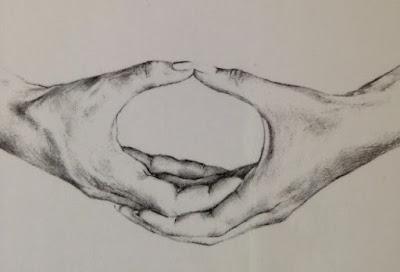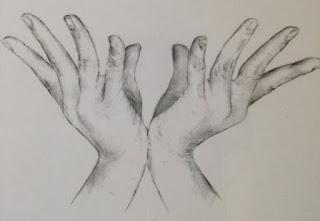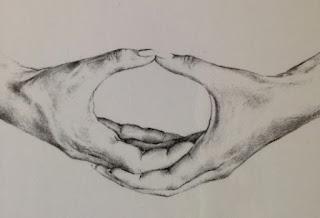 This is part 8 in my series on the chakras. The last post focused on Ajna (Third Eye) Chakra and how we journey toward wisdom. This post will explore Sahasrara (Crown) Chakra.
This is part 8 in my series on the chakras. The last post focused on Ajna (Third Eye) Chakra and how we journey toward wisdom. This post will explore Sahasrara (Crown) Chakra.Sahasrara translates as “union” and is often referred to as a stepping-stone between heaven and earth, a connection to the fabric of existence, and the source of spiritual awakening. Energetically this chakra is said to be located at or above the crown of the head. Physically, it is associated with the pineal gland, located in the middle of the brain between the two hemispheres. The main function of this gland is to produce melatonin, a hormone that helps regulate our circadian rhythms, determining when we sleep, wake up, and feel tired or alert.The element related to the Crown Chakra depends on the source you consult. Some say thought, while others say ether or light. Joseph Le Page says it’s the source of all the elements.There are important life lessons connected to this chakra. Here are several to consider:
In working with this chakra (or any of the chakras), keep in mind these words from Joseph Le Page:
“The great wisdom of the chakras and their seven levels is that each level must be explored, accepted, realized and integrated. No aspect of our lives, including our deepest core issues, our most painful emotional traumas, or our darkest shadow aspects, can be overlooked or bypassed.”This is an important point. In the search for spiritual connection we may encounter within ourselves a tendency to deny the body, repress our difficult issues, and ignore our shadow aspects. You can read about the shadow in my post What Does the Shadow Say.The challenge then becomes: how do we work with the Crown Chakra safely while addressing what we may deny or wish to ignore? It helps to start with the body because that aspect of being is up close and personal. Asana, with variations when needed, can be a first step, followed by energy practices and meditation when you are ready.Asana
Several asana are recommended for working with the Crown Chakra. They are:
- Natarajasana: Dancer Pose
- Sirsasana: Headstand
- Urdhva Dhanurasana: Wheel Pose
- Shashangasana: Rabbit Pose
- Yogendra Yogamudra: The Symbol or Seal of Yoga
- Savasana: Relaxation or Corpse Pose
Energy Practice: Ananta and Mandala MudrasWhen you are ready for an energy practice, try either the Ananta or Mandala Mudras from Joseph and Lilian Le Page’s Mudras for Healing and Transformation. Note that Ananta Mudra is contraindicated for hypertension, headache and stroke. You can practice Mandala Mudra, for which there are no cautions, instead.Ananta Mudra (Gesture of Infinity)
 This mudra is said to unfold the Crown Chakra, harmonize the entire chakra system, and support optimal balance in all systems of the body.
This mudra is said to unfold the Crown Chakra, harmonize the entire chakra system, and support optimal balance in all systems of the body.- Join the hands in Prayer position in front of your heart.
- Keep the base of your palms together and spread all the fingers and thumbs wide apart like an unfolding lotus.
- Relax your shoulders back and down, with your spine aligned in its natural curves.
Mandala Mudra (Gesture of the Circle)
 This mudra is said to be helpful for glimpsing deeper states of meditation beyond the personality and supporting all systems of the physical body for optimal functioning.
This mudra is said to be helpful for glimpsing deeper states of meditation beyond the personality and supporting all systems of the physical body for optimal functioning.- Rest your left hand in your lap, with the palm facing upward.
- Rest the back of your right hand onto the palm of your left hand.
- Touch the tips of your thumbs gently together, forming a wide-open circle shape.
- Relax your shoulders back and down, with your elbows held slightly away from your body and your spine aligned in its natural curves.
MeditationOf course, the jewel in the Crown Chakra is meditation. The two basic paths of meditation practice are mindfulness and concentration. Both offer many techniques to choose from.Concentration meditation techniques work by channeling your mind's full attention into a single focus, such as a sound, music, breath, picture, an object, or a physical position. The goal is to keep bringing your attention back to the selected focus when your mind wanders. And your mind will wander. In concentration meditation you can think of the mind as a puppy on a short leash.On the other hand, as Jon Kabat-Zinn, the founder of the Mindfulness-Based Stress Reduction program and author of, Full Catastrophe Living, says, “Mindfulness is moment-to-moment awareness. It is a systematic approach to developing new kinds of control and wisdom in our lives, based on our inner capacities for relaxation, paying attention, awareness and insight.” In mindfulness meditation you can think of the mind as a puppy on a longer leash, which allows it to move freely but with full awareness of what it is experiencing, including wandering. See Nina's post All Good But Not Equivalent: Meditation Types for more information about these two basic types of meditation.If you are a beginning meditator try starting with 3- 5 minutes and slowly work your way up to a length of time that is comfortable for you and that you can commit to. I started with 3 minutes and have worked my way up to 25 minutes. My ultimate goal is 30 minutes 6 days a week.If you encounter difficult material that you’ve been denying, repressing, or resisting you can imagine or visualize a thick Glass Wall between you and what is making you uncomfortable. This creates distance between you and what is floating up. If the Glass Wall does not lessen your discomfort, it may be time to seek professional help.The Crown Chakra can be thought of as a stepping-stone between heaven and earth. Therefore, let each of us step with care, clarity, and confidence as we seek our source.
Beth's self-awareness newsletter is published six times a year. It features informative, inspiring and entertaining tips for finding clarity, contentment, and resilience in a complicated world. For more information and to sign up for the newsletter go to www.bethgibbs.com.
Follow Yoga for Healthy Aging on Facebook ° To order Yoga for Healthy Aging: A Guide to Lifelong Well-Being, go to Amazon, Shambhala, Indie Boundor your local bookstore.
